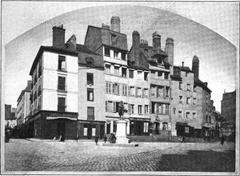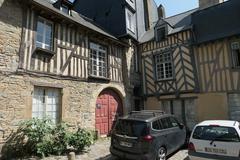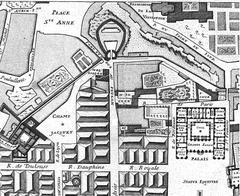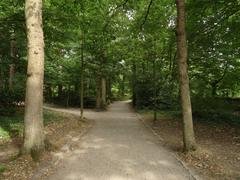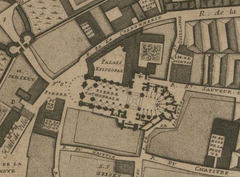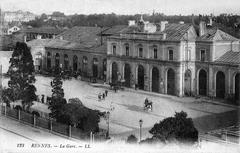
Centre Pénitentiaire de Rennes Visiting Hours, Tickets, and Travel Guide
Date: 04/07/2025
Introduction
Nestled in the historic city of Rennes, Brittany, the Centre Pénitentiaire de Rennes stands as a powerful testament to France’s evolving penal history, architectural innovation, and shifting societal values. Originally inaugurated in the late 19th century, this facility has served as the nation’s primary women’s prison, a site of wartime resistance, and more recently, a focal point for cultural engagement and historical reflection.
Despite its continued operation as a correctional institution, the Centre Pénitentiaire de Rennes occasionally opens its doors to the public on special occasions, inviting visitors to discover its rich heritage, distinctive architecture, and the broader context of justice and rehabilitation in France. This comprehensive guide offers detailed historical background, practical visitor information, and travel advice to ensure a meaningful and informed visit.
For the latest updates on visiting hours, ticketing, and special events, refer to official resources such as Rennes Métropole, Service-Public.fr, and academic resources like ARCHITECTURE ET PRISON.
Table of Contents
- Introduction
- Historical Background and Architectural Evolution
- Architectural Features and Significance
- Cultural and Community Impact
- Visitor Information
- Practical Tips and Regulations
- Frequently Asked Questions (FAQ)
- References and Further Reading
Historical Background and Architectural Evolution
Origins and Construction
The Centre Pénitentiaire de Rennes was inaugurated in 1878, following designs by the architect Alfred-Nicolas Normand. Conceived as the “Maison Centrale de Force et de Correction,” its strategic location above Rennes’ railway station signified both surveillance and deterrence, making the prison a daily reminder of state authority for the city’s residents (ici.rennes.fr).
Early Years and Religious Administration
Uniquely designated for female inmates, the prison could accommodate up to 1,000 women. Until 1907, daily life was overseen by nuns from the Congregation of Marie-Joseph, embodying 19th-century ideals of moral reform through spiritual guidance.
Interwar Period and Centralization
By the 1930s, with the closure of other women’s penitentiaries in France, Rennes became the country’s central prison for women serving long sentences. From 1940 onward, it officially housed all women sentenced to more than six months.
World War II: Resistance and Memory
During the German occupation, the prison held hundreds of female résistantes and political prisoners under dire conditions. Notably, a mass protest in 1944 led to punitive measures against over 100 detainees. The prison also functioned as a transit point for deportations to Ravensbrück, cementing its role as a site of suffering and solidarity.
Postwar Developments and Modern Use
After the war, the prison continued to serve as a women’s penitentiary. In recent years, parts of the complex have been repurposed for cultural and community events, reflecting evolving perspectives on justice, rehabilitation, and heritage.
Architectural Features and Significance
The prison’s design incorporates the panoptic principles championed by Jeremy Bentham, with a central rotunda and radiating wings enabling constant surveillance. Constructed from local purplish schist stone, the imposing exterior features a distinctive blue entrance and central dome.
Internally, the facility functioned as a “city within a city,” with separate zones for cells, workshops, medical care, and administrative offices. The east wing originally housed women and was later adapted for specialized care. Over the decades, renovations improved living conditions and security, but the original architectural logic remains largely intact (ARCHITECTURE ET PRISON).
Cultural and Community Impact
Throughout its existence, the Centre Pénitentiaire de Rennes has stood as a locus of memory, resistance, and social transformation. During World War II, its use as a detention site for résistantes and political prisoners secured its place as a powerful symbol of remembrance (ici.rennes.fr).
In the 21st century, the prison has been partially reimagined as a civic and cultural venue. Art installations, such as Ipin’s 300 m² mural and soundscape, and events during European Heritage Days draw thousands of visitors, fostering renewed public engagement with the site’s layered history.
Visitor Information
Visiting Hours and Tickets
- Public Access: The prison is not open for general tourism. Public visits are possible only during special occasions (e.g., European Heritage Days, cultural events) when guided tours may be offered.
- Tickets: Entry is typically free during official open days; however, some guided tours require advance reservation.
- Authorization: Family and legal visits must be arranged in advance through the penitentiary administration and are subject to security checks and documentation.
For up-to-date details, check Service-Public.fr.
Access and Security Procedures
- Identification: All visitors must present valid, government-issued photo ID.
- Security Screening: Expect thorough checks, including metal detectors and bag inspections. Electronic devices and photography are strictly prohibited.
- Dress Code: Modest, non-revealing attire is required. Offensive slogans or uniforms are not allowed.
Accessibility
- Limited wheelchair access is available in parts of the facility; contact the administration ahead of your visit to arrange for accommodations (AccèsLibre).
- Some areas may remain inaccessible due to the historic structure.
Travel and Nearby Attractions
- Address: Rue du Petit Pré, 35132 Vezin-le-Coquet, France
- Transport: The prison is located approximately 7 km from Rennes’ city center. It is accessible by car, taxi, and public transport from Rennes SNCF station (Mapcarta).
- Nearby Sites: Explore Rennes’ historic center, the Parlement de Bretagne, Parc du Thabor, and Musée des Beaux-Arts.
Practical Tips and Regulations
- Arrival: Arrive at least 30 minutes early for security processing.
- Language: French is the primary language; bring a translator if needed.
- Gifts: Only pre-approved items may be left for inmates and must be inspected.
- Children: Minors must be accompanied by a legal guardian and appropriate identification.
COVID-19 and Health Protocols
- As of July 2025, visitors may be subject to health screenings or mask requirements. Confirm current policies prior to arrival.
Frequently Asked Questions (FAQ)
Q: Can tourists visit the Centre Pénitentiaire de Rennes?
A: General tourism is not permitted. Only authorized individuals (family, legal representatives) or visitors on special open days may access the site.
Q: How do I schedule a visit?
A: Contact the prison administration for authorization and to book appointments.
Q: Are guided tours available?
A: Guided tours occur only during special events, such as European Heritage Days.
Q: Is the site accessible for people with disabilities?
A: Accessibility is limited; contact the administration in advance for arrangements.
Q: Are there nearby attractions?
A: Yes, Rennes’ city center, the Parliament of Brittany, and local museums are all within easy reach.
References and Further Reading
- Rennes Métropole – Official Heritage and Cultural Events
- Service-Public.fr – Centre Pénitentiaire de Rennes Directory and Access
- Ministry of Justice – France
- ARCHITECTURE ET PRISON – Academic Analysis
Summary and Final Tips
The Centre Pénitentiaire de Rennes is a landmark where architecture, history, and the ongoing story of justice in France converge. Whether accessed during special heritage events or for family and legal visits, the site offers a rare window into the nation’s penal past and present. Plan ahead, respect all regulations, and enhance your experience by exploring nearby cultural sites in Rennes.
For the most current information, always consult official resources and consider visitor tools like the Audiala app for guided content and updates.





